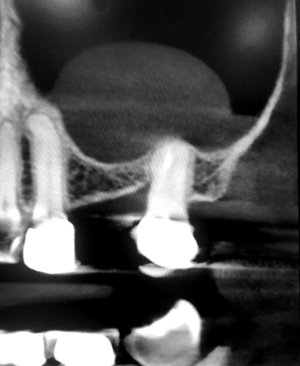Allergies can blur diagnosis

Tooth pain or sinus pain? Knowing the difference can be perplexing for both patients and professionals.
“Diagnosis is really difficult. There’s no question about that,” says Dr. Karl Woodmansey, clinical assistant professor in endodontics. During his 17 years in general practice, he ran into this quandary quite often. “Diagnosis was always challenging, deciding, ‘When do I refer to a physician or an ENT? When is this an endodontic problem?’”
Such dilemmas have become somewhat easier to navigate with high-resolution imaging capabilities and an interdisciplinary approach, he says. CBCT, or cone-beam computed tomography, has been revolutionary with its computerized, cone-shape beam that produces 3D digital images.
“Old-school, two-dimensional radiographs are just this agglomeration of everything between the film and X-ray tubehead. Now we can see these very precise slices where we can look right in one particular space in the sinus,” he says.

Dr. Gabrielle Dizon ’13, ’17, a general dentist who practices in North Dallas, says every now and then patients come in complaining about tooth pain that is sinus related, or vice versa.
“Sometimes patients say, ‘I have a lot of pressure on my upper teeth’ just in general. ‘My teeth kind of hurt.’ And I’ll ask them, ‘Do you have a lot of sinus issues or do you have a lot of seasonal allergies?’ They’ll say, ‘Yeah, I’ve been pretty stuffed up lately,’” she says.
Dizon sometimes recommends that her sinus-suffering patients take decongestants and/or any allergy medication they have. A nasal wash system like a neti pot used for a week often does the trick, too, she says.
“If it still doesn’t improve, we have to take a different route of diagnosis. I see a lot of times it does resolve,” she says.
Woodmansey cites Dr. Howard Selden and Dr. David August’s still-relevant 1970 study, “Maxillary Sinus Involvement—an Endodontic Complication,” as proof that nailing down a diagnosis has posed a conundrum for decades.
According to the study, “Sinusitis of dental origin, though difficult to determine exactly, has been estimated to occur anywhere from 15 percent to 75 percent of the time.” And that’s a lot, says Woodmansey, sharing another study excerpt: “‘It is also generally accepted that the symptoms of maxillary sinusitis can emulate pain of dental origin.’ It basically talks about how there’s this confusion.”

To move beyond that gray area, dentists need to pinpoint where the patient feels pressure, which is part of Dizon’s litmus test. If it’s generalized, it’s most likely sinus related. If the pain or pressure is localized in one tooth and presents itself on a radiograph above the tooth, she says, she can narrow it down to either the sinus right above the tooth or the tooth itself. Dental imaging helps diagnose the tooth’s vitality.
“One patient had gone to the ENT before seeing me, she’d been on a couple of rounds of antibiotics, and the pain wasn’t going away. So I took a look at her teeth and did the diagnostic test,” says Dizon.
She referred the patient to an endodontist, who found a vertically cracked tooth that needed extraction. The CBCT in the endodontist’s office often provides the needed clarity.
“Usually if it’s something I’m stumped on, she can use that extra tool. If it causes pain, this tooth is either cracked or the pulpal tissue is inflamed. If it’s coming from the pulp, we need to do a root canal,” she says.
Woodmansey’s initial fact-finding protocol includes tapping on the suspect tooth. If it hurts, it’s probably a tooth problem and not a sinus problem, he says.
“A sinus issue is not the first thing we think of in the endodontic department,” Woodmansey says. “We think by the time they get to us, it’s the tooth and not the sinus. But that’s not always true.”
If that same tapping on numerous maxillary teeth is painful, then a sinus issue is more likely.
“Think about when people have allergic sinusitis in both right and left sinuses simultaneously,” he says. “It’s not usually just one side, which is another clue that it’s not a tooth problem if it’s bilateral.”
The most common complaint Woodmansey hears from patients is how they can feel throbbing or a pressure change when they walk down stairs or drop their head below their knees.
“Those are signs of sinus problems,” he says, adding that he refers such patients to their primary care physician or an ear, nose and throat specialist.